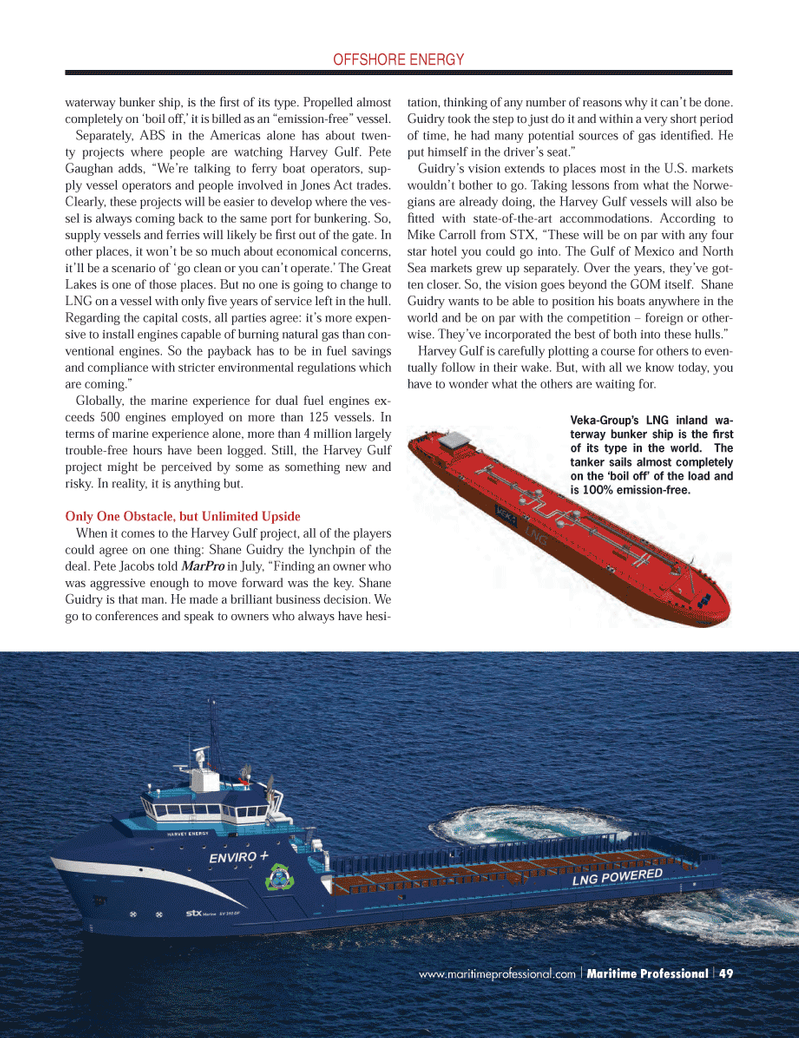
Page 49: of Maritime Logistics Professional Magazine (Q3 2012)
Classification Societies, Quality & Design
Read this page in Pdf, Flash or Html5 edition of Q3 2012 Maritime Logistics Professional Magazine
waterway bunker ship, is the Þ rst of its type. Propelled almost completely on Ôboil off,Õ it is billed as an Òemission-freeÓ vessel. Separately, ABS in the Americas alone has about twen- ty projects where people are watching Harvey Gulf. Pete Gaughan adds, ÒWeÕre talking to ferry boat operators, sup- ply vessel operators and people involved in Jones Act trades. Clearly, these projects will be easier to develop where the ves- sel is always coming back to the same port for bunkering. So, supply vessels and ferries will likely be Þ rst out of the gate. In other places, it wonÕt be so much about economical concerns, itÕll be a scenario of Ôgo clean or you canÕt operate.Õ The Great Lakes is one of those places. But no one is going to change to LNG on a vessel with only Þ ve years of service left in the hull. Regarding the capital costs, all parties agree: itÕs more expen- sive to install engines capable of burning natural gas than con- ventional engines. So the payback has to be in fuel savings and compliance with stricter environmental regulations which are coming.Ó Globally, the marine experience for dual fuel engines ex- ceeds 500 engines employed on more than 125 vessels. In terms of marine experience alone, more than 4 million largely trouble-free hours have been logged. Still, the Harvey Gulf project might be perceived by some as something new and risky. In reality, it is anything but. Only One Obstacle, but Unlimited Upside When it comes to the Harvey Gulf project, all of the players could agree on one thing: Shane Guidry the lynchpin of the deal. Pete Jacobs told MarPro in July, ÒFinding an owner who was aggressive enough to move forward was the key. Shane Guidry is that man. He made a brilliant business decision. We go to conferences and speak to owners who always have hesi- tation, thinking of any number of reasons why it canÕt be done. Guidry took the step to just do it and within a very short period of time, he had many potential sources of gas identiÞ ed. He put himself in the driverÕs seat.Ó GuidryÕs vision extends to places most in the U.S. markets wouldnÕt bother to go. Taking lessons from what the Norwe- gians are already doing, the Harvey Gulf vessels will also be Þ tted with state-of-the-art accommodations. According to Mike Carroll from STX, ÒThese will be on par with any four star hotel you could go into. The Gulf of Mexico and North Sea markets grew up separately. Over the years, theyÕve got- ten closer. So, the vision goes beyond the GOM itself. Shane Guidry wants to be able to position his boats anywhere in the world and be on par with the competition Ð foreign or other- wise. TheyÕve incorporated the best of both into these hulls.Ó Harvey Gulf is carefully plotting a course for others to even- tually follow in their wake. But, with all we know today, you have to wonder what the others are waiting for. Veka-Group?s LNG inland wa- terway bunker ship is the rst of its type in the world. The tanker sails almost completely on the ?boil off? of the load and is 100% emission-free. OFFSHORE ENERGYwww.maritimeprofessional.com | Maritime Professional | 49

 48
48

 50
50
